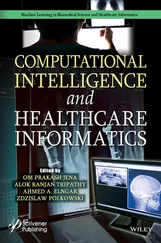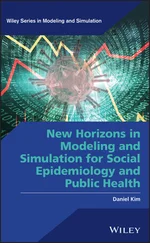Computational Modeling and Simulation Examples in Bioengineering
Здесь есть возможность читать онлайн «Computational Modeling and Simulation Examples in Bioengineering» — ознакомительный отрывок электронной книги совершенно бесплатно, а после прочтения отрывка купить полную версию. В некоторых случаях можно слушать аудио, скачать через торрент в формате fb2 и присутствует краткое содержание. Жанр: unrecognised, на английском языке. Описание произведения, (предисловие) а так же отзывы посетителей доступны на портале библиотеки ЛибКат.
- Название:Computational Modeling and Simulation Examples in Bioengineering
- Автор:
- Жанр:
- Год:неизвестен
- ISBN:нет данных
- Рейтинг книги:3 / 5. Голосов: 1
-
Избранное:Добавить в избранное
- Отзывы:
-
Ваша оценка:
- 60
- 1
- 2
- 3
- 4
- 5
Computational Modeling and Simulation Examples in Bioengineering: краткое содержание, описание и аннотация
Предлагаем к чтению аннотацию, описание, краткое содержание или предисловие (зависит от того, что написал сам автор книги «Computational Modeling and Simulation Examples in Bioengineering»). Если вы не нашли необходимую информацию о книге — напишите в комментариях, мы постараемся отыскать её.
Computational Modeling and Simulation Examples in Bioengineering
Computational Modeling and Simulation Examples in Bioengineering:
Computational Modeling and Simulation Examples in Bioengineering
Computational Modeling and Simulation Examples in Bioengineering — читать онлайн ознакомительный отрывок
Ниже представлен текст книги, разбитый по страницам. Система сохранения места последней прочитанной страницы, позволяет с удобством читать онлайн бесплатно книгу «Computational Modeling and Simulation Examples in Bioengineering», без необходимости каждый раз заново искать на чём Вы остановились. Поставьте закладку, и сможете в любой момент перейти на страницу, на которой закончили чтение.
Интервал:
Закладка:
10 10 Venkatasubramaniam, A.K., Fagan, M.J., Mehta, T. et al. (2004). A Comparative Study of Aortic Wall Stress Using Finite Element Analysis for Ruptured and Non‐ruptured Abdominal Aortic Aneurysms. Eur. J. Vasc. Endovasc. Surg. 28 (2): 168–176.
11 11 Choke, E., Cockerill, G., Wilson, W.R.W. et al. (2005). A review of biological factors implicated in abdominal aortic aneurysm rupture. Eur. J. Vasc. Endovasc. Surg. 30: 227–244.
12 12 Fillinger, M.F., Marra, S.P., Raghavan, M.L., and Kennedy, F.E. (2003). Prediction of rupture risk in abdominal aortic aneurysm during observation: wall stress versus diameter. J. Vasc. Surg. 37: 724–732.
13 13 Fillinger, M.F., Raghavan, M.L., Marra, S.P. et al. (2002). In vivo analysis of mechanical wall stress and abdominal aortic aneurysm rupture risk. J. Vasc. Surg. 36: 589–597.
14 14 Upchurch, G.R. Jr. and Schaub, T.A. (2006). Abdominal aortic aneurysm. Am. Fam. Phys. 73: 1198–1204.
15 15 Sonesson, B., Sandgren, T., and Lanne, T. (1999). Abdominal aortic aneurysm wall mechanics and their relation to risk of rupture. Eur. J. Vasc. Endovasc. Surg. 18: 487–493.
16 16 Doyle, B.J., Callanan, A., Walsh, M.T. et al. (2009). A finite element analysis rupture index (FEARI) as an additional tool for abdominal aortic aneurysm rupture prediction. Vasc. Dis. Prev. 6: 114–121.
17 17 Doyle, B.J., Cloonan, A.J., Walsh, M.T. et al. (2010). Identification of rupture locations in patient‐specific abdominal aortic aneurysms using experimental and computational techniques. J. Biomech. 43: 1408–1416.
18 18 Doyle, B.J., Corbett, T.J., Callanan, A. et al. (2009). An experimental and numerical comparison of the rupture locations of an abdominal aortic aneurysm. J. Endovasc. Ther. 16: 322–335.
19 19 Doyle, B.J., Grace, P.A., Kavanagh, E.G. et al. (2009). Improved assessment and treatment of abdominal aortic aneurysms: the use of 3D reconstructions as a surgical guidance tool in endovascular repair. Ir. J. Med. Sci. 178: 321–328.
20 20 Biasetti, J. and Gasser, T.C. (2012). A fluido‐chemical model to predict the growth of intra‐luminal thrombus in abdominal aortic aneurysms, ECCOMAS 2012. 6th European Congress on Computational Methods in Applied Sciences and Engineering, Vienna, Austria (10–14 September 2012).
21 21 Biasetti, J., Gasser, T.C., Auer, M. et al. (2010). Hemodynamics of the normal aorta compared to fusiform and saccular abdominal aortic aneurysms with emphasis on a potential thrombus formation mechanism. Ann. Biomed. Eng. 38 (2): 380–390.
22 22 Georgakarakos, E., Ioannou, C., Kamarianakis, Y. et al. (2010). The role of geometric parameters in the prediction of abdominal aortic aneurysm wall stress. Eur. J. Vasc. Endovasc. Surg. 39: 42–48.
23 23 Georgakarakos, E., Ioannou, C.V., Papaharilaou, Y. et al. (2013). Peak wall stress does not necessarily predict the location of rupture in abdominal aortic aneurysms. Eur. J. Vasc. Endovasc. Surg. 39 (3): 302–304.
24 24 Vorp, D.A. (2007). Biomechanics of abdominal aortic aneurysm. J. Biomech. 40: 1887–1902.
25 25 VASCOPS Vascular Diagnostics (2007). On‐line survey: clinical assessment of AAA rupture risk: are biomechanical predictors needed? http://www.vascops.com(accessed 12 September 2021).
26 26 Alcorn, H.G., Wolfson, S.K. Jr., Sutton‐Tyrrell, K. et al. (1996). Risk factors for abdominal aortic aneurysms in older adults enrolled in The Cardiovascular Health Study. Arterioscler. Thromb. Vasc. Biol. 16: 963–970.
27 27 Derubertis, B.G., Trocciola, S.M., Ryer, E.J. et al. (2007). Abdominal aortic aneurysm in women: prevalence, risk factors, and implications for screening. J. Vasc. Surg. 46: 630–635.
28 28 Forsdahl, S.H., Singh, K., Solberg, S. et al. (2009). Risk factors for abdominal aortic aneurysms: a 7‐year prospective study: the Tromso Study, 1994–2001. Circulation 119: 2202–2208.
29 29 Svensjo, S., Bjorck, M., and Wanhainen, A. (2013). Current prevalence of abdominal aortic aneurysm in 70‐year‐old women. Br. J. Surg. 100: 367–372.
30 30 Lederle, F.A., Johnson, G.R., Wilson, S.E. et al. (2001). Abdominal aortic aneurysm in women. J. Vasc. Surg. 34: 122–126.
31 31 Singh, K., Bonaa, K.H., Jacobsen, B.K. et al. (2001). Prevalence of and risk factors for abdominal aortic aneurysms in a population‐based study: the Tromso Study. Am. J. Epidemiol. 154: 236–244.
32 32 Kent, K.C., Zwolak, R.M., Egorova, N.N. et al. (2010). Analysis of risk factors for abdominal aortic aneurysm in a cohort of more than 3 million individuals. J. Vasc. Surg. 52: 539–548.
33 33 Lederle, F.A., Johnson, G.R., Wilson, S.E. et al. (2000). The aneurysm detection and management study screening program: validation cohort and final results. Aneurysm Detection and Management Veterans Affairs Cooperative Study Investigators. Arch. Intern. Med. 160: 1425–1430.
34 34 Lederle, F.A., Nelson, D.B., and Joseph, A.M. (2003). Smokers' relative risk for aortic aneurysm compared with other smoking‐related diseases: a systematic review. J. Vasc. Surg. 38: 329–334.
35 35 Jahangir, E., Lipworth, L., Edwards, T.L. et al. (2015). Smoking, sex, risk factors and abdominal aortic aneurysms: a prospective study of 18 782 persons aged above 65 years in the Southern Community Cohort Study. J. Epidemiol. Community Health 69 (5): 481–488.
36 36 Darling, R.C., Messina, C.R., Brewster, D.C., and Ottinger, L.W. (1977). Autopsy study of unoperated abdominal aortic aneurysms. The case for early resection. Circulation 56 (Suppl. 3): 161–164.
37 37 Stringfellow, M.M., Lawrence, P.F., and Stringfellow, R.G. (1987). The influence of aorta‐aneurysm geometry upon stress in the aneurysm wall. J. Surg. Res. 42: 425–433.
38 38 Vorp, D.A., Raghavan, M.L., and Webster, M. (1998). Mechanical wall stress in abdominal aortic aneurysm: inuence of diameter and asymmetry. J. Vasc. Surg. 27: 632–639.
39 39 Raghavan, M.L. and Vorp, D.A. (2000). Toward a biomechanical tool to evaluate rupture potential of abdominal aortic aneurysm: identification of a finite strain constitutive model and evaluation of its applicability. J. Biomech. 33 (4): 475–482.
40 40 Raghavan, M.L., Kratzberg, J., Castro de Tolosa, E.M. et al. (2006). Regional distribution of wall thickness and failure properties of human abdominal aortic aneurysm. J. Biomech. 39: 3010–3016.
41 41 Raghavan, M.L., Vorp, D.A., Federle, M.P. et al. (2000). Wall stress distribution on three‐dimensionally reconstructed models of human abdominal aortic aneurysm. J. Vasc. Surg. 31: 760–769.
42 42 Vande Geest, J.P., Sacks, M.S., and Vorp, D.A. (2006). A planar biaxial constitutive relation for the luminal layer of intra‐luminal thrombus in abdominal aortic aneurysms. J. Biomech. 39: 2347–2354.
43 43 Scotti, C.M., Jimenez, J., Muluk, S.C., and Finol, E.A. (2008). Wall stress and flow dynamics in abdominal aortic aneurysms: finite element analysis vs. fluid–structure interaction. Comput. Methods Biomech. Biomed. Eng. 11 (3): 301–322.
44 44 Scotti, C.M., Shkolnik, A.D., Muluk, S., and Finol, E.A. (2005). Fluid–structure interaction in abdominal aortic aneurysms: effects of asymmetry and wall thickness. Biomed. Eng. Online 4 (4): 64.
45 45 Finol, E.A. and Amon, C.H. (2001). Blood flow in abdominal aortic aneurysms: pulsatile flow hemodynamics. J. Biomech. Eng. 123: 474–484.
46 46 Finol, E.A. and Amon, C.H. (2002). Flow‐induced wall shear stress in abdominal aortic aneurysms: part I – steady flow hemodynamics. Comput. Methods Biomech. Biomed. Eng. 5 (4): 309–318.
47 47 Federico, S. and Gasser, T.C. (2010). Nonlinear elasticity of biological tissues with statistical fiber orientation. J. R. Soc. Interf. 7 (47): 955–966.
48 48 Hardin, R.H. and Sloane, N.J.A. (1996). McLaren's improved snub cube and other new spherical designs in three dimentions. Discret. Comput. Geom. 15: 429–441.
Читать дальшеИнтервал:
Закладка:
Похожие книги на «Computational Modeling and Simulation Examples in Bioengineering»
Представляем Вашему вниманию похожие книги на «Computational Modeling and Simulation Examples in Bioengineering» списком для выбора. Мы отобрали схожую по названию и смыслу литературу в надежде предоставить читателям больше вариантов отыскать новые, интересные, ещё непрочитанные произведения.
Обсуждение, отзывы о книге «Computational Modeling and Simulation Examples in Bioengineering» и просто собственные мнения читателей. Оставьте ваши комментарии, напишите, что Вы думаете о произведении, его смысле или главных героях. Укажите что конкретно понравилось, а что нет, и почему Вы так считаете.












